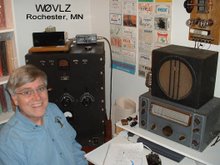I've gotten my NC-81X back on the air! It is paired with my Stancor 10P for a mid-class 1939 AM/CW station. I'm using it on 40 and 80 meter CW.

The NC-81X sat in the National receiver price lineup below the NC-101XA. Comparing the two, the NC-81X had transformerless AC/DC power, no S-Meter and no RF stage but I found it really performs pretty good. Shifting the IF to 1560KC helped eliminate any image problem.
Along the way to adding it to my station lineup I did change a few things. First the obvious one, I changed out all of the paper and electrolytic caps. I left the original electrolytics in place but replaced them with modern electrolytics mounted under the chassis. I'm not a fan of transformerless AC/DC receivers and this one had a short between the chassis and the metal case. Unless run with an isolation transformer it was a shock hazard waiting to happen. I had a small isolation transformer big enough to handle the NC-81X B+ requirements so I wired it into the receiver to supply B+ and I left the filament string connected across 120 VAC. I addition I fused each side of the AC line and added a three wire/grounded cord. Now this radio is safe to use but repair work under the chassis still requires a "real" isolation transformer. The NC-81X is not an HRO though. While very usable it still tends to FM/wobble on strong CW signals. I suspect the B+ needs to be regulated.
The 1938 list price for the NC-81X was $165 while the NC-101X listed for $215. This was back when the
US average wages per year was $1,730 compared to about $60,000 today. I bet 10% of my wages towards a new radio would lead to some interesting dinner time conversation. No wonder National introduced the NC-44 at an even lower price point ($82.50) and by 1939 dealers sold these radios at a very steep discount (NC-101X for $129 and NC-81X for $99).
 I've now finished up the transmitter power supply so I'll soon be testing it out on the air. The transformer is rated for 560V at 270mA so should certainly easily handle my 50-70W transmitter. At 31 pounds, mostly iron, I don't plan to move this one around much.
I've now finished up the transmitter power supply so I'll soon be testing it out on the air. The transformer is rated for 560V at 270mA so should certainly easily handle my 50-70W transmitter. At 31 pounds, mostly iron, I don't plan to move this one around much.




